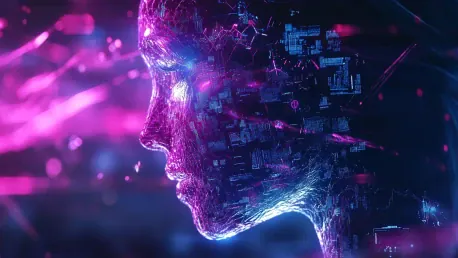As advanced technologies continue to permeate various facets of our daily lives, artificial intelligence (AI) has become a pivotal discussion point, particularly concerning its impact on the workforce. The overwhelming question is whether AI serves to bolster the productivity and efficiency of human labor, or if it heralds the obsolescence of many job roles. Recent research by Anthropic, an AI safety and research company, sheds light on this critical issue. By analyzing over 4 million AI user prompts, they discovered that the primary use of AI is to augment, not replace, jobs in today’s dynamic workforce.
AI Augmentation in the Workforce
Predominance of Augmentation Over Automation
The comprehensive analysis indicates that AI is predominantly used to enhance the productivity and capabilities of workers rather than automate their roles entirely. The study revealed that about 57% of AI applications are geared towards augmenting jobs, compared to 43% directed at automation. This demonstrates that AI is being integrated into existing workflows to streamline processes and improve precision rather than eliminating the need for human workers altogether.
A closer look at the tasks frequently augmented by AI reveals that workers often use these tools for various technical domains. For instance, AI assists software engineers with software modification, debugging code, and troubleshooting networks. These tasks require considerable technical precision, and AI’s role is more about providing support rather than replacing the engineers. Essentially, AI is becoming an invaluable tool in the toolkit of professionals, helping them achieve greater efficiency and productivity.
Specialized Technical Roles and AI Integration
The study highlighted that computer and mathematical workers, particularly software engineers, are the heaviest users of AI-driven tasks. This demographic accounted for 37.2% of tasks augmented by AI. The tasks in this category include software applications development, code refinement, and systems maintenance. AI tools are designed to help these professionals reduce the time spent on repetitive and mundane activities, allowing them to focus on more complex and innovative aspects of their work.
Aside from software engineers, other mid-to-high salary roles, including copywriters and bioinformatics technicians, also show a substantial integration of AI support. AI is utilized for tasks such as content brainstorming, predictive text generation, and data analysis. However, integration is minimal in positions requiring significant manual dexterity or specialized human judgment, such as shampooers and obstetricians. These findings suggest that the adaptability of AI technology is highly dependent on the nature of the job.
AI’s Collaborative Role
Enhancing Worker Capabilities Through Collaboration
A significant outcome of Anthropic’s study is the collaborative nature of AI use in the workforce. In many instances, workers employ AI tools to double-check their work, acquire new skills, brainstorm ideas, and efficiently complete repetitive tasks. Even in scenarios characterized by heavy AI usage, the technology is generally used to support and enhance the skills of workers rather than to replace them outright. This collaborative dynamic underscores the role of AI as a supportive asset in human labor rather than an antagonistic force.
Workers frequently rely on AI for verifying details, performing complex computations, and generating creative solutions. By doing so, they can minimize errors and increase the accuracy of their output. Additionally, AI’s ability to parse through large amounts of data quickly allows workers to glean insights that would be time-consuming to obtain manually. The collaborative engagement between workers and AI appears to be a harmonious blend, where technology augments human capabilities, leading to improved outcomes and innovation.
Importance of Task-Specific AI Assistance
Another intriguing aspect is how AI is tailored for task-specific assistance, catering to the unique needs of various professions. For example, technical writers might use AI for grammar checking and content organization, while bioinformatics technicians could rely on it for data processing and analysis. This specificity lends itself to a nuanced application of AI technology, where it supplements the task without overshadowing human expertise.
Moreover, the study noted that only 4% of jobs used AI for at least 75% of their tasks, while over one-third incorporated AI for at least 25% of tasks. This statistic highlights a trend where AI is integrated into multiple aspects of a job without becoming the primary executor of all tasks. It paints a picture of a future where AI aids in job evolution by facilitating more efficient task management and opening opportunities for employees to engage in higher-value work.
The Future of AI in the Workforce
Potential Limitations and Reassuring Perspectives
Despite the optimistic insights, Anthropic identified certain caveats in their study. One of the limitations is the possibility that users might have leveraged the AI tool, Claude, for non-work-related activities. Additionally, it’s conceivable that users refined AI outputs post-reception, further tailoring them to specific requirements. These nuances indicate that while AI’s role is largely augmentative, it’s essential to interpret the data with an understanding of context and user intent.
However, these limitations do not overshadow the promising findings of the analysis. The context-sensitive application of AI means that its deployment in the workforce is primarily aimed at supporting human roles. This provides a reassuring perspective for workers concerned about potential job displacement. The study underscores the perspective that AI, when implemented mindfully, can serve as a valuable complement to human labor, fostering a symbiotic relationship between technology and the workforce.
Broadening the Scope of AI Application
As advanced technologies increasingly infiltrate various aspects of our daily lives, artificial intelligence (AI) has become a crucial point of discussion, particularly regarding its impact on the workforce. The pressing question is whether AI enhances the productivity and efficiency of human labor or if it signals the end of many job roles. Recent research from Anthropic, a company focused on AI safety and research, provides valuable insights into this issue. By examining over 4 million AI user prompts, Anthropic discovered that the primary role of AI in today’s dynamic workforce is to supplement and enhance existing jobs, rather than replace them. This data underscores a trend where AI acts as a tool for human workers, augmenting their capabilities and allowing them to perform tasks more efficiently. In the context of a rapidly changing work environment driven by technological advancements, it is crucial to understand that AI, for the most part, is designed to work alongside humans, not to make them obsolete.









